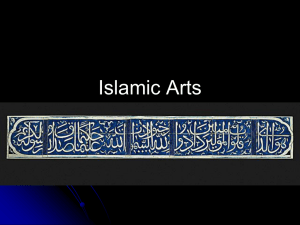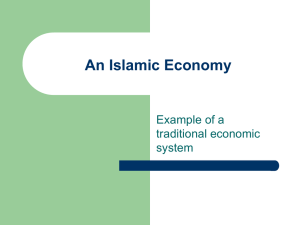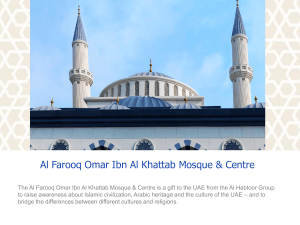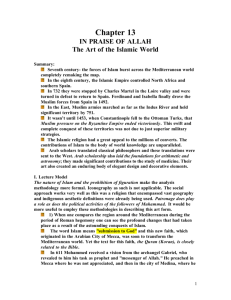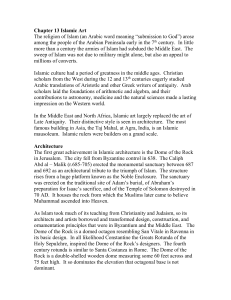islamic_art_chapter_8
advertisement
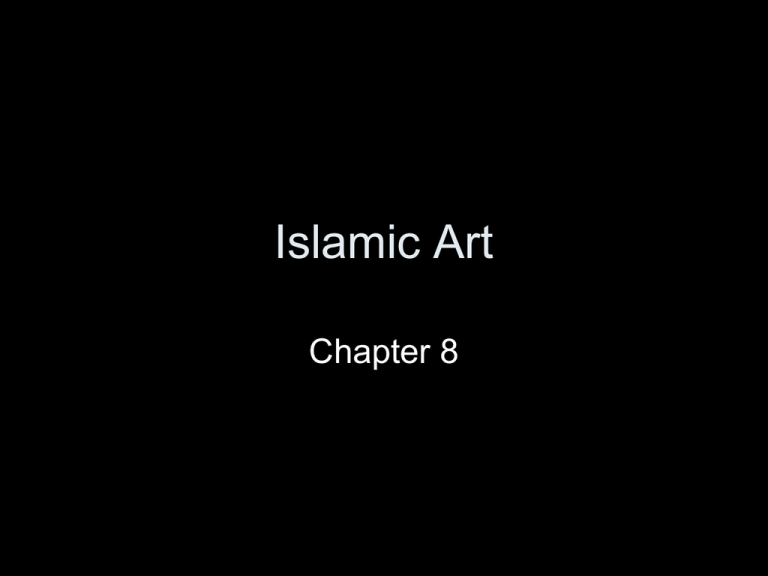
Islamic Art Chapter 8 The Kaaba is the "cubic" shrine in Mecca, the center of Islamic worship and the holiest place in Islam. ("Kaaba" means "cube" in Arabic.) It was originally a shrine built by Abraham devoted to the one God, about 2000 B.C. • Muslims pray five times a day facing the Kaaba in Mecca, and if they are able, they will make a Pilgrimage, or "hajj", there at least once in their lives. • At the time before Islam, the Kaaba was used to house about 360 idols for the various tribes of Arabia. The Prophet Muhammad was against idol worship and preached that there was one God (Allah). This started the hostilities against him and his followers. After leaving Mecca and going to Medina, the Prophet Muhammad and his followers finally returned triumphantly into Mecca. There the Muslims destroyed the idols and rededicated the Kaaba to the one God. Dome of the Rock • This is the oldest Muslim building which has survived basically intact in its original form. It was built by the Caliph Abd al-Malik and completed in 691 CE. The building encloses a huge rock located at its center, from which, according to tradition, the Prophet Muhammad ascended to heaven at the end of his Night Journey. In the Jewish tradition this is the Foundation Stone, the symbolic foundation upon which the world was created, and the place of the Binding of Isaac. The Caliph Omar is said to have cleared the waste which had accumulated on the rock during the Byzantine period. The structure is octagonal and the dome is borne by a double system of pillars and columns. The walls, ceiling, arches, and vaults are decorated with floral images. The dome, on the inside, is covered with colored and gilded stucco. Dome of the Rock Cross section of the Dome of the Rock (Tower of David Museum) Dome of the Rock Interior Dome of the Rock • The plot of land on the elevated stone platform known as Haram Ash-Sharif on Temple Mount upon which sits the Dome of the Rock is sacred to three of the world's major monotheistic religions: Judaism, Christianity, and Islam. • The site was first consecrated by the Israelites of Exodus. Later, according to Jewish tradition, Abraham prepared to sacrifice his son Isaac upon a rock that protruded from the centre of the platform. Later still, upon the same platform, Solomon erected his temple. • For Christians, in addition to the Old Testament Jewish associations, the Temple Mount was revered because of its place in the life and ministries of Jesus Christ. • For Moslems, the rock was sanctified by the story of the Prophet Mohammed's Miraaj or Night Journey to Jerusalem and back to Mecca (Qur'an 17:1). From the top of the rock, Mohammed began his ascent to Heaven. Detail from Frieze, Façade of the Palace at Mshatta • Islamic belief in Aniconism and the doctrine of unity (al-twahid) demanded a rich vocabulary of abstract, geometric forms that translated into the architecture of mosques. • Artists reiterated these forms in complex decoration that covered the surface of every work of art from large buildings, to rugs, paintings and small sacred objects. Jordan, Mshatta Palace, c. 750, Plan Plan of Typical, Early Islamic Mosque The numbers below correspond to the circled numbers to the right. 1. Qibla wall. 2. Mihrab niche. 3. Hypostyle hall. 4. Courtyard (or "sahn"). 5. Minaret. The Great Mosque, Kairouan, Tunisia, 836 - 875 The Great Mosque , Cordoba (785-786) The double horseshoe arcades of the prayer-hall Dome of the great mosque of Cordoba, 965 Arches and Muqarnas Horseshoe Arches Tiled Moorish style Arches in Seville Palace, Reales Alcazares. Pointed arch Muqarnas is the Arabic word for stalactite vault, an architectural ornament developed around the middle of the tenth century in north eastern Iran and almost simultaneously, but apparently independently, in central North Africa. Page from Koran in kufic script, from Syria. Ink, pigments, and gold on vellum, 9th century Leaf from a Qur’an manuscript Ahmad ibn alSuhravardi al-Bakri, calligrapher Muhammad ibn Aybak, illuminator Baghdad, Iraq Ilkhanid, 1307–1308 Ink, colors, and gold on paper; 20 3/16 x 14 1/2 in. (51.3 x 36.8cm) The most complete documentation of Samanid art is to be found in its ceramics, and during the 9th century, the wares of Transoxiana were very popular throughout the eastern provinces of Persia. The best-known and most refined pottery of this Samarkand type is that bearing large inscriptions in Kufic (the earliest version of Arabic script used in the Koran, named after the city Kufa in Iraq) painted in black on a white background. Part of the St. Josse silk, Khorasan 10th century. The inscription wishes 'glory and prosperity to Abu Mansur Bukhtegin, may God prolong (His favours to him?)'. Mosque lamps • Throughout the Islamic world, mosques and other religious structures were frequently illuminated with oil lamps suspended from the rafters or ceiling. During the fourteenth century, hundreds of such lamps were commissioned by the powerful Mamluk ruler and patron of the arts, Sultan Hasan (reigned 1344–51 and 1354–61), for his vast religious complex in Cairo. • These mosque lamps were elaborately decorated with paint, gilt, and enamel, and often included the sultan's name as symbolic representations of a specific Koranic verse (sura 24, verse 35), known as the Light verse, which encircles the tall neck of the lamp. • They provided light by means of a wick placed in a container of oil within the lamp. Egypt, Mamuk dynasty, about 1350-5 glass, enameled and gilded • The lamps are also decorated with a bold inscription frieze containing the name and titles of Sayf al-Din Shaykhu al-Nasiri, an important patron of art and architecture in Cairo. His heraldic device incorporating a red cup appears in the centre of the roundels on the neck and the underside of the lamp. Isfahan is already a city of ancient history and considerable wealth when Shah Abbas decides, in 1598, to turn it into a magnificent capital. It has a Masjid-i-Jami, or Friday Mosque, dating from the Seljuk period (11th-12th century), still surviving today and noted for its fine patterned brickwork. And it has a thriving school of craftsmen skilled in the making of polychrome ceramic tiles. Islamic Terms • Mihrab - A mihrab is a niche in the wall which points the worshipers toward Mecca. • Minbar - A minbar is a "pulpit", or a place from which a religious leader (an "imam") speaks to the people. It looks something like a staircase. • Minarets - Minarets are towers of a mosque. From the minaret a person (a "muezzin") calls people to prayer five times a day. Mihrab Isfahan, Iran Ilkhanid, 1354 Mosaic of monochrome-glaze tiles on composite body set on plaster; 135 1/16 x 113 11/16 in. Egypt, Cairo, Mihrab and Minbar of the Mosque of Sultan Hasan, 13561360. This liwan, or niche is the side of the mosque used as a madrasa by the Shafi, one of the four schools of Islamic legal and theological thought. Alhambra-Court of Lions Five Pillars of Islam Art and Context • The Five Pillars of Islam are core beliefs that shape Muslim thought, deed, and society. A Muslim who fulfills the Five Pillars of Islam, remains in the faith of Islam, and sincerely repents of his sins, will make it to Jannah (paradise). If he performs the Five Pillars but does not remain in the faith, he will not be saved. The First Pillar • Shahada • The Shahada is the Islamic proclamation that "There is no true God except Allah and Muhammad is the Messenger of Allah." • This is the confession that Allah is the one and only true God, that Allah alone is worthy of worship, that Allah alone is the sovereign lord who does what he wills with whoever he wills. It means that all his rules and laws found in the Koran are to be followed. It means that the Christian doctrine of God as a Trinity is false as are all other belief systems including pantheism. • Muhammad is the true and greatest prophet of Allah and recognition of Muhammad as the Prophet of God is required. It was through Muhammad that Allah conveyed the last and final revelation. The Second Pillar • Prayer (Salat) • Prayer involves confession of sins which begins with the purification of the body and ends with the purification of the soul. Prayer is performed five times a day. The first prayer is at dawn and the last at sunset. • The names of the prayers are Fajr, Dhuhr, Asr, Maghrib, Isha. The Maghrib prayer is the sunset prayer. Isha is the prayer that is said after sunset. There is also a prayer that is said right after Fajr known as Shurooq. Prayer (Salat) Third Pillar • Fasting (Saum) • The month of Ramadan is the month of fasting in Islam. It is an act of worship where the faithful follower denies his own needs and seeks Allah. Usually, this fasting entails no drinking or eating during the daylight hours for the entire month of Ramadan. Fourth Pillar • Alms-giving or charity (Zakat) • Charity given to the poor. It benefits the poor and it helps the giver by moving him towards more holiness and submission to Allah. Alms-giving is considered a form of worship to God. Fifth Pillar • Pilgrimage (Hajj) • This is the pilgrimage to Mecca. All Muslims, if they are able, are to make a pilgrimage to Mecca. It involves financial sacrifice and is an act of worship. Muslims must make the pilgrimage the first half of the last month of the lunar year Muqarnas dome, Hall of the Abencerrajes, Palace of the Lions, built between 1354 - 1391 Portable Arts • Metal Work – inherited skills of the Roman and Byzantine craftsmen • Ceramics – development of lustrous metallic surface • Textiles – traditional silk weaving passed from Persian to Islamic artisans Griffin. Fatimid, (Egyptian), Islamic 11th century Pen box, 13th century Western Iran or northern Iraq (al-Jazira) Brass inlaid with gold and silver; H. 1 5/8 in. (4.1 cm), L. 8 3/4 in. (22.2 cm) • Muslim metalworkers produced large numbers of pen boxes, many of which were richly decorated with inlays of gold, silver, and copper. A typical medieval Islamic calligrapher's pen box is an elongated rectangular object with rounded corners, about ten inches long, three inches wide, and two inches tall. In its simple construction, it is composed of a main body and a lid with two hinges along one of the long sides and a clasp on the opposite side. The interior includes a receptacle to hold the inkwell in one corner while the remaining space is reserved for a variety of reed pens and penknives. The Macy Jug, from Iran, 1215 – 16 Composite body glazed, painted fritware* and incised with pierced outer shell. 6 5/8” x 7 ¼” *a flux that is stabilized by melting it with silica and regrinding it into a fine powder Muslim Tapestry preserved in the Monastery of the Royal Strikes Burgos. It is called "banner of Navas de Tolosa," because it was taken by King Alfonso VIII of Castile the Almohad ben Muhammad Yaqub. Very richly decorated, upper and lower bands bearing phrases written religious significance. To the sides, the scripts are made so that they can be read by the setback of the tapestry. In the center, a star with eight points evolves in different ways to death in a circle, according to Muslim taste for geometry. The predominant colors red and gold. Medallion rug with a field of flowers, 17th century; Safavid Probably Kirman, Iran Wool pile on cotton, wool, and silk foundation; 81 x 56 in. (205.7 x 142.4 cm) Textiles • Roses, hyacinths, narcissi, campanula, irises, carnations, and lilies are among the many types of flowers that blossom in the field and borders of this carpet, which is generally attributed to the seventeenthcentury production of Kirman, Iran. The flora are arranged symmetrically in pattern and color around a central octagonal medallion and four quarter medallions in the corners. The art of illumination, especially that of book covers, might have provided the inspiration for the central and corner medallion design, which was woven into so many Persian carpets. The decorative theme of the medallion has Central Asian roots and was known in the Timurid period, but its popularity greatly increased during the rule of the Safavids and beyond. Carpet Making • Making knotted carpets were surely regarded as a tradition in ancient Persia like in today. The oldest piece of rug in the world is an Iranian knotted one called Pazyrik (named after an area where it has been discovered in a frozen tomb in Southern Siberia). It dates back to 400300 B.C. • Iranian carpets consist of warp, weft, silk pile, wool, cotton or fuzz knotted with weft forming the flesh of carpets. In different parts of Iran, carpet makers created their own styles and schools. Techniques were sometimes different from tribe to tribe or city to city. • Plain flat-weave or kilim weave implies a tapestry-like flat woven structure. The coloured woollen threads forming the motifs are interwoven across the warps, not from edge to edge, but only where the pattern and colour make it necessary. The result is a thinner, soft yet hardy reversible tapestry-like weave. Symmetrical Knot, used extensively in Iran Asymmetrical knot used extensively in Turkey Manuscripts and painting • Calligraphy is the most highly regarded and most fundamental element of Islamic art. It is significant that the Qur’an, the book of God's revelations to the Prophet Muhammad, was transmitted in Arabic, and that inherent within the Arabic script is the potential for developing a variety of ornamental forms. The employment of calligraphy as ornament had a definite aesthetic appeal but often also included an underlying talismanic component. While most works of art had legible inscriptions, not all Muslims would have been able to read them. One should always keep in mind, however, that calligraphy is principally a means to transmit a text, albeit in a decorative form. • Objects from different periods and regions vary in the use of calligraphy in their overall design, demonstrating the creative possibilities of calligraphy as ornament. In some cases, calligraphy is the dominant element in the decoration. In these examples, the artist exploits the inherent possibilities of the Arabic script to create writing as ornament. An entire word can give the impression of random brushstrokes, or a single letter can develop into a decorative knot. In other cases, highly esteemed calligraphic works on paper are themselves ornamented and enhanced by their decorative frames or backgrounds. Calligraphy can also become part of an overall ornamental program, clearly separated from the rest of the decoration. In some examples, calligraphy can be combined with vegetal scrolls on the same surface though often on different levels, creating an interplay of decorative elements. • Consisting of, or generated from, such simple forms as the circle and the square, geometric patterns were combined, duplicated, interlaced, and arranged in intricate combinations, thus becoming one of the most distinguishing features of Islamic art. However, these complex patterns seem to embody a refusal to adhere strictly to the rules of geometry. As a matter of fact, geometric ornamentation in Islamic art suggests a remarkable amount of freedom; in its repetition and complexity, it offers the possibility of infinite growth and can accommodate the incorporation of other types of ornamentation as well. In terms of their abstractness, repetitive motifs, and symmetry, geometric patterns have much in common with the so-called arabesque style seen in many vegetal designs. Calligraphic ornamentation also appears in conjunction with geometric patterns. • The four basic shapes, or "repeat units," from which the more complicated patterns are constructed are: circles and interlaced circles; squares or four-sided polygons; the ubiquitous star pattern, ultimately derived from squares and triangles inscribed in a circle; and multisided polygons. It is clear, however, that the complex patterns found on many objects include a number of different shapes and arrangements, allowing them to fit into more than one category Leaf from a Qur’an, 1302– 8; Ilkhanid Iraq (Baghdad) Ink, gold, and colors on paper; 17 x 13 7/8 in. (43.2 x 35.2 cm) • This illuminated page originally formed the right half of a double-page opening to a section of a Qur’an. It combines the three main Islamic types of nonfigural decoration: calligraphy, vegetal patterns, and geometric patterns. The vegetal patterns here are the classical scrolls utilized as the background to the calligraphy, within the compartments of the geometric interlace, and in the text frame and margin medallion. Two ground colors are used to introduce additional patterning. The Ottoman Empire • The empire they built was the largest and most influential of the Muslim empires of the modern period, and their culture and military expansion crossed over into Europe. Not since the expansion of Islam into Spain in the eighth century had Islam seemed poised to establish a European presence as it did in the sixteenth and seventeenth centuries. Like that earlier expansion, the Ottomans established an empire over European territory and established Islamic traditions and culture that last to the current day (the Muslims in Bosnia are the last descendants of the Ottoman presence in Europe). • The Ottoman empire lasted until the twentieth century. While historians like to talk about empires in terms of growth and decline, the Ottomans were a force to be reckoned with, militarily and culturally, right up until the breakup of the empire in the first decades of this century. The real end to the Ottoman culture came with the secularization of Turkey after World War II along European models of government. The transition to a secular state was not an easy one and its repercussions are still being felt in Turkish society today; nevertheless, secularization represents the real break with the Ottoman tradition and heritage. The Selimiye Mosque (Turkish: Selimiye Camii) is a mosque in the city of Edirne, Turkey. The mosque was commissioned by Sultan Selim II and was built by architect Mimar Sinan between 1568 and 1574. It was considered by Sinan to be his masterpiece and is one of the highest achievements of Islamic architecture. Sinan (1489 -1588) • Prolific and brilliant master-architect of the Ottoman Empire, holding responsibilities for an enormous range of public works. One of his greatest buildings was the Süleymaniye Mosque in Istanbul (1550–7) which shows how much he had absorbed of Byzantine forms and construction, especially those of the Church of Hagia Sophia, but Sinan improved and rationalized the system of buttressing for the central dome, and clarified the subsidiary elements. Interior, Mosque of Sultan Selim Illuminated Manuscripts and Tugras • A peculiarly Ottoman Turkish phenomenon is the calligraphic "tughra" (handsign), unique to each sultan, which gives his name and titles and appears at the head of every firman (royal edict). The spectacularly bold calligraphy contrasts with the dense yet delicate flowering plants, arabesques, and floral scrolls. Tughra of Sultan Sulaiman the Magnificent, 16th century; Ottoman period (c.1555-60) attributed to Istanbul, Turkey Ink, colors and gold on paper; H: 20 1/2 in. W: 25 3/8 in.
